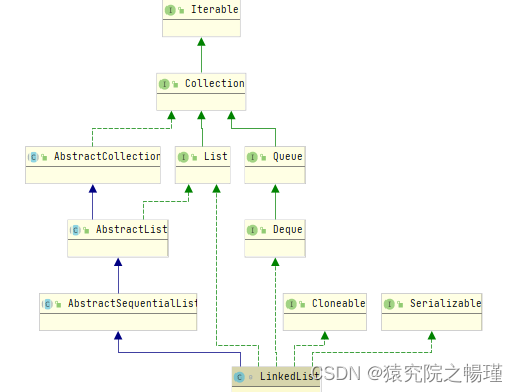目录
LinkedList() 用于创建一个新的空linkedList;
LinkedList(Collection c) 使用一个集合创建一个新的linkedList。
5.1.4、contains(Object o)判断是否含有o元素
5.2.2、removeLast()删除并返回最后一个元素。
5.2.5、remove(int index)删除指定位置的元素
5.2.6、remove(Object o) 删除某一个元素,返回是否成功
set(int index,E element) 设置指定位置的元素。
5.4.2、 add(int index,E element)向指定位置插入元素
5.4.4、addAll(int index, Collection c)
一、与ArrayList类对比梳理
list是集合Collection的子接口,是一种有序且允许重复值的单列集合,
实现类为ArrayList类和LinkedList类
ArrayList类通过基于Object[ ]数组实现List接口;
LinkedList通过”链表“实现List接口, 采用双向链表结构.
二、LinkedList的定义
public class LinkedList<E>
extends AbstractSequentialList<E>
implements List<E>, Deque<E>, Cloneable, java.io.Serializable
{2.1、LinkedList的关系类图

2.2、LinkedList类继承与实现的细节
1.实现Cloneable和Serializable接口主要是为了能够进行深拷贝和序列化。
2.LinkedLisk类继承自AbstractSequentialList。
3.实现了List接口,这个接口定义了一些常见的容器的方法,
4.实现了Deque接口,这个接口可以简单的认为是一个双端队列,两头都可以进可以出,
5.AbstractList抽象类专门用来实现 LinkedList 和ArrayList 中共有的方法,实现代码的复用
如果直接继承实现的方式会造成冗余,
6.AbstractSequentialList 继承自 AbstractList:
实现了get(int index)、set(int index, E element)、add(int index, E element)
和 remove(int index)这些骨干性函数。降低了List接口的复杂度。
是 LinkedList 的直接父类,并且只支持迭代器按顺序访问
7.是非同步的。
三、数据存储原理
private static class Node<E> {
E item;
Node<E> next;
Node<E> prev;
Node(Node<E> prev, E element, Node<E> next) {
this.item = element;
this.next = next;
this.prev = prev;
}
}3.1、内部类Node
在LinkedList中有一个一个的Node,这些Node中封装着数据值和地址值,
3.2、双向链表
底层的数据存储结构是基于双向链表实现,在其内部有一个内部类Node

既然是双向链表,那么必定存在一种数据结构——我们可以称之为节点,
节点实例保存数据,前一个节点的位置信息和后一个节点位置信息。

四、构造方法
LinkedList() 用于创建一个新的空linkedList;
public LinkedList() {
}LinkedList(Collection<? extends E> c) 使用一个集合创建一个新的linkedList。
public LinkedList(Collection<? extends E> c) {
this();
addAll(c);
}实例:
public static void main(String[] args) {
LinkedList<String> linkedList1 = new LinkedList<>();
System.out.println(linkedList1);
String[] arr = {"H", "e", "l", "l", "o"};
LinkedList<String> linkedList2 = new LinkedList<>(Arrays.asList(arr));
System.out.println(linkedList2);
}执行结果:
[]
[H, e, l, l, o]五、方法的讲解
5.1 查询
5.1.1、get(int index)返回指定位置的元素
public E get(int index) {
checkElementIndex(index);
return node(index).item;
}5.1.2、获取特殊位置的元素
getFirst()返回第一个元素
public E getFirst() {
final Node<E> f = first;
if (f == null)
throw new NoSuchElementException();
return f.item;
}
element()返回第一个元素
public E element() {
return getFirst();
}peek() 返回第一个元素
public E peek() {
final Node<E> f = first;
return (f == null) ? null : f.item;
}
peekFirst()返回头部元素
public E peekFirst() {
final Node<E> f = first;
return (f == null) ? null : f.item;
}
peekLast()返回尾部元素
public E peekLast() {
final Node<E> l = last;
return (l == null) ? null : l.item;
}5.1.3、getLast()获取最后一个元素
public E getLast() {
final Node<E> l = last;
if (l == null)
throw new NoSuchElementException();
return l.item;
}5.1.4、contains(Object o)判断是否含有o元素
public boolean contains(Object o) {
return indexOf(o) != -1;
}5.2 删除元素
5.2.1、removeFirst()删除并返回第一个元素
public E removeFirst() {
final Node<E> f = first;
if (f == null)
throw new NoSuchElementException();
return unlinkFirst(f);
}
5.2.2、removeLast()删除并返回最后一个元素。
public E removeLast() {
final Node<E> l = last;
if (l == null)
throw new NoSuchElementException();
return unlinkLast(l);
}5.2.3、poll()删除并返回第一个元素。
public E poll() {
final Node<E> f = first;
return (f == null) ? null : unlinkFirst(f);
}5.2.4、remove()删除并返回第一个元素
public E remove() {
return removeFirst();
}5.2.5、remove(int index)删除指定位置的元素
public E remove(int index) {
checkElementIndex(index);
return unlink(node(index));
}5.2.6、remove(Object o) 删除某一个元素,返回是否成功
public boolean remove(Object o) {
if (o == null) {
for (Node<E> x = first; x != null; x = x.next) {
if (x.item == null) {
unlink(x);
return true;
}
}
} else {
for (Node<E> x = first; x != null; x = x.next) {
if (o.equals(x.item)) {
unlink(x);
return true;
}
}
}
return false;
}5.2.7、clear() 清空链表
public void clear() {
// Clearing all of the links between nodes is "unnecessary", but:
// - helps a generational GC if the discarded nodes inhabit
// more than one generation
// - is sure to free memory even if there is a reachable Iterator
for (Node<E> x = first; x != null; ) {
Node<E> next = x.next;
x.item = null;
x.next = null;
x.prev = null;
x = next;
}
first = last = null;
size = 0;
modCount++;
}
5.3 修改元素
set(int index,E element) 设置指定位置的元素。
public E set(int index, E element) {
checkElementIndex(index);
Node<E> x = node(index);
E oldVal = x.item;
x.item = element;
return oldVal;
}5.4 增加元素
5.4.1、add(E e) 链表末尾添加,返回是否成功
public boolean add(E e) {
linkLast(e);
return true;
}5.4.2、 add(int index,E element)向指定位置插入元素
public void add(int index, E element) {
checkPositionIndex(index);
if (index == size)
linkLast(element);
else
linkBefore(element, node(index));
}5.4.3、addAll(Collection<? extends E> c),
将一个集合的所有元素添加到链表后面,返回是否成功
public boolean addAll(Collection<? extends E> c) {
return addAll(size, c);
}5.4.4、addAll(int index, Collection<? extends E> c)
将一个集合的所有元素添加到链表的指定位置后面,返回是否成功
public boolean addAll(int index, Collection<? extends E> c)5.4.5、addFirst(E e),添加到第一个元素
public void addFirst(E e) {
linkFirst(e);
}5.4.6、addFirst(E e),添加到第一个元素
public void addLast(E e) {
linkLast(e);
}
5.4.7、其余方法(在对象为栈时,用到的方法)
public boolean offer(E e):向链表末尾添加元素,返回是否成功
public boolean offerFirst(E e):头部插入元素,返回是否成功
public boolean offerLast(E e):尾部插入元素,返回是否成功
5.5 遍历
5.5.1、for循环遍历
for (int size = linkedList.size(), i = 0; i < size; i++) {
System.out.println(linkedList.get(i));
}
5.5.2、forEach()遍历
for (String element: linkedList) {
System.out.println(element);
}
5.5.3、迭代器遍历
Iterator iter = linkedList.iterator();
while (iter.hasNext()) {
System.out.println(iter.next());
}




















 259
259











 被折叠的 条评论
为什么被折叠?
被折叠的 条评论
为什么被折叠?








